By Sergio Harding
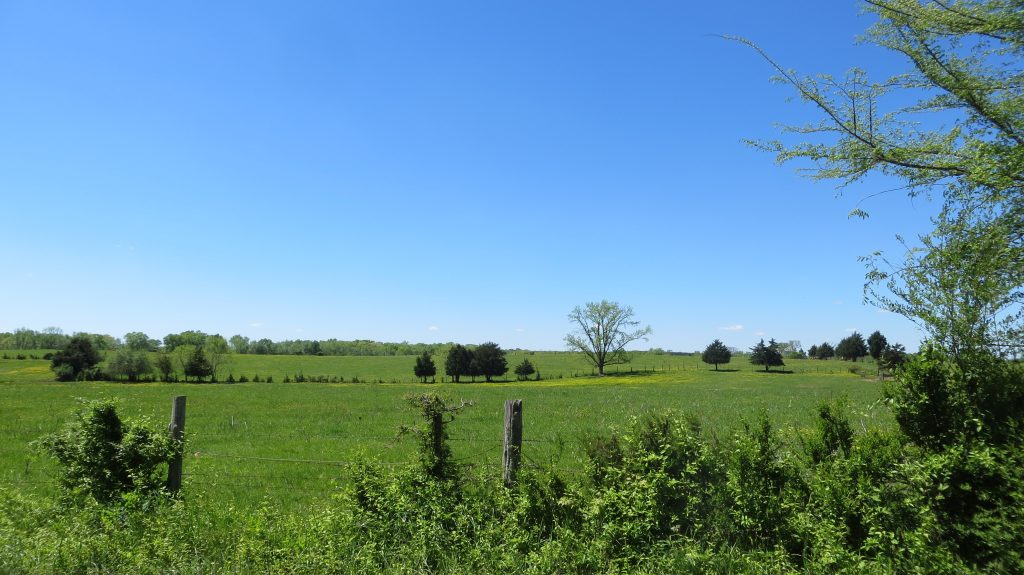
Fencerow Habitat – Mecklenburg County (CO Sergio Harding)
What do lightly-grazed pastures, powerline right-of-ways, and regenerating clear-cuts have in common? They are all examples of shrubland habitats here in Virginia. Shrublands are home to a wide variety of birds that to date are under-represented in the Atlas. Read on for how you can bump up your contribution to the Atlas this year by focusing more of your survey time on shrublands.
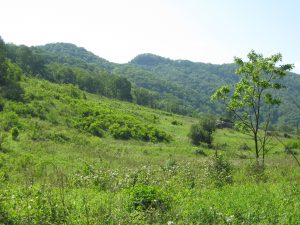
Old Field (CO Sergio Harding)
What do shrublands look like?
Shrublands are open habitats that contain small to medium-sized woody plants, generally under 15 ft. In some habitats, such as open cow pastures, shrubs can be few and scattered; in others, such as clear-cuts a few years post-harvest, they can be abundant and widespread. Additional shrubland habitat in the Commonwealth can be found in abandoned fields, restored strip mines, shrubby wetlands, vegetated fencerows and even in your back yard.
If left unmanaged by humans, or undisturbed by natural events like storms or wildfires, shrublands will continue to grow over time and eventually revert to forest. This can present a problem for the birds that depend on them, as their habitat can disappear over just a few years. However, rural Virginia still has an abundance of shrublands in need of atlasing.
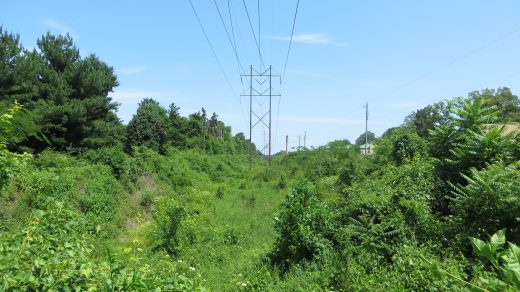
Powerline Cut (CO Sergio Harding)
What birds use shrublands?
The number of bird species found in shrublands during the breeding season is truly impressive. Step into a shrubby pasture to be greeted by the ping-pong trill of the Field Sparrow, while the song of the Eastern Towhee invites you for tea and the Eastern Kingbird sounds off like electric sparks spritzing from a live wire.
Perhaps you’ll spot a brightly colored Orchard Oriole, Northern Cardinal and Blue Grosbeak, or, if you’re lucky, a Loggerhead Shrike as it hunts from its favorite perch.

Blue Grosbeak (CO Dick Rowe)
Joining the shrike are kestrels and bluebirds, perched on trees and electric lines while scanning the ground for prey, as Barn and Tree Swallows forage overhead. Mockingbirds, thrashers and catbirds all make their home in shrublands, as do Indigo Buntings and White-eyed Vireos. Looking for warblers? Yellow Warbler, Prairie Warbler, Common Yellowthroat and Yellow-breasted Chats are all widespread shrubland denizens.
In shrub habitats in western Virginia you’ll find handsome Chestnut-sided Warblers and, under the right conditions, less common species like Golden-winged Warbler and its cousin, the Blue-winged Warbler. While searching for these western shrub specialists, keep an ear out for Willow Flycatcher. East of the Blue Ridge? Listen for the iconic whistle of the Northern Bobwhite.
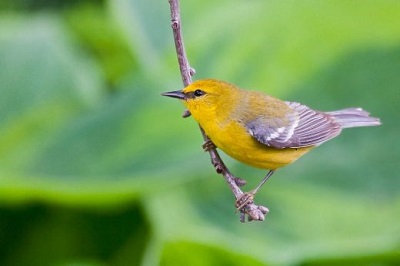
Blue-winged Warbler (CO Bob Schamerhorn)
The list of species breeding in or otherwise using shrubby habitats goes on. In addition, shrublands abut other habitat types, often including woodlots and forests. A visit to a shrubby patch will likely yield additional species associated with forest edges and forest interior habitats.
Where should I survey shrublands?
In these final two years of the Atlas, the focus should be on surveying habitat within Priority Blocks. Within these blocks, do you have a friend, acquaintance or family member who owns a farm or has done a timber harvest in the past few years? Ask to visit their property to survey for birds. Don’t have access to shrublands on private or public lands? No problem! Open, shrubby habitat is very often accessible from public roadsides. Pasturelands in the western part of the state are concentrated along roads in the valleys, and, along with other shrubby agricultural habitat, are widespread in other areas of the state. Timber harvests and powerline cuts can also often be surveyed from rural roadsides. When conducting roadside surveys, always be sensitive to local residents and do not compromise your or others’ safety by parking where it is not safe to do so.
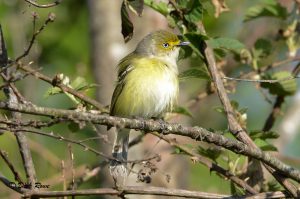
White-eyed Vireo (CO Dick Rowe)
Shrubland habitats found in the contexts described above are especially prevalent in areas of the state with little Atlasing effort to date – these include southwest Virginia and virtually the entire south-central Piedmont. Directing your efforts to Priority Blocks in these geographic areas is a great opportunity to make a big impact on the Atlas in these final two years. But wherever you live in the state, or wherever you choose to survey, maximize your contribution to the Atlas by focusing on shrublands!
Quick Guide to types of shrubland habitats in Virginia: although this is not an exhaustive list, the following are the most commonly found shrubland habitats in the Commonwealth –
- shrubby pastures
- regenerating clear-cuts
- powerline right-of-ways
- abandoned fields
- restored strip mines
- shrubby wetlands
- vegetated fencerows and hedgerows
Quick Guide to bird species associated with shrubland habitats in Virginia: while some species depend exclusively on shrublands, others may use shrublands but can also be found in other habitat types. Although this is not a complete list, examples of bird species that can be found in open habitats with a shrub component include, in no particular order:
- Field Sparrow
- Eastern Towhee
- Eastern Kingbird
- Orchard Oriole
- Northern Cardinal
- Blue Grosbeak
- Loggerhead Shrike
- American Kestrel
- Eastern Bluebird
- Barn Swallow
- Tree Swallow
- Northern Mockingbird
- Brown Thrasher
- Gray Catbird
- Indigo Bunting
- White-eyed Vireo
- Yellow Warbler
- Prairie Warbler
- Common Yellowthroat
- Yellow-breasted Chat
- Chestnut-sided Warbler
- Golden-winged Warbler
- Blue-winged Warbler
- Willow Flycatcher
- Northern Bobwhite

